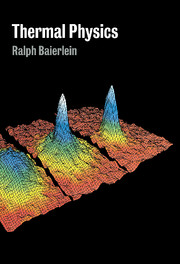Book contents
- Frontmatter
- Contents
- Preface
- 1 Background
- 2 The Second Law of Thermodynamics
- 3 Entropy and Efficiency
- 4 Entropy in Quantum Theory
- 5 The Canonical Probability Distribution
- 6 Photons and Phonons
- 7 The Chemical Potential
- 8 The Quantum Ideal Gas
- 9 Fermions and Bosons at Low Temperature
- 10 The Free Energies
- 11 Chemical Equilibrium
- 12 Phase Equilibrium
- 13 The Classical Limit
- 14 Approaching Zero
- 15 Transport Processes
- 16 Critical Phenomena
- Epilogue
- Appendix A Physical and Mathematical Data
- Appendix B Examples of Estimating Occupation Numbers
- Appendix C The Framework of Probability Theory
- Appendix D Qualitative Perspectives on the van der Waals Equation
- Index
Epilogue
Published online by Cambridge University Press: 05 June 2012
- Frontmatter
- Contents
- Preface
- 1 Background
- 2 The Second Law of Thermodynamics
- 3 Entropy and Efficiency
- 4 Entropy in Quantum Theory
- 5 The Canonical Probability Distribution
- 6 Photons and Phonons
- 7 The Chemical Potential
- 8 The Quantum Ideal Gas
- 9 Fermions and Bosons at Low Temperature
- 10 The Free Energies
- 11 Chemical Equilibrium
- 12 Phase Equilibrium
- 13 The Classical Limit
- 14 Approaching Zero
- 15 Transport Processes
- 16 Critical Phenomena
- Epilogue
- Appendix A Physical and Mathematical Data
- Appendix B Examples of Estimating Occupation Numbers
- Appendix C The Framework of Probability Theory
- Appendix D Qualitative Perspectives on the van der Waals Equation
- Index
Summary
All too easily, a book on thermal physics leaves the impression of a collection of applications: blackbody radiation, Debye theory, conduction electrons, van der Waals equation, and so on. Those applications are vital; they connect the theoretical and experimental worlds. Yet even more important is to come away from the book with a sense of its underlying theoretical structure. What is its equivalent of the equation F = ma in a mechanics text? Or of Maxwell's equations in a book on electromagnetism?
In this book, the key theoretical ideas are the Second Law of Thermodynamics, the canonical probability distribution, the partition function, and the chemical potential. Of these, the Second Law of Thermodynamics comes first logically and is most nearly the central organizing principle. The majority of the applications, however, found us using the latter three items: P(Ψj) = (1/Z)exp(−Ej/kT), Z, or µ. By comparison with mechanics or electromagnetism, thermal physics suffers in that its most basic principle, the Second Law of Thermodynamics, is separated by layers of secondary theory from the physical applications. Perhaps that reflects the inherent difficulty of coping with 1020 particles all at once, or perhaps the root lies in the diversity of topics that can be addressed.
- Type
- Chapter
- Information
- Thermal Physics , pp. 419Publisher: Cambridge University PressPrint publication year: 1999



